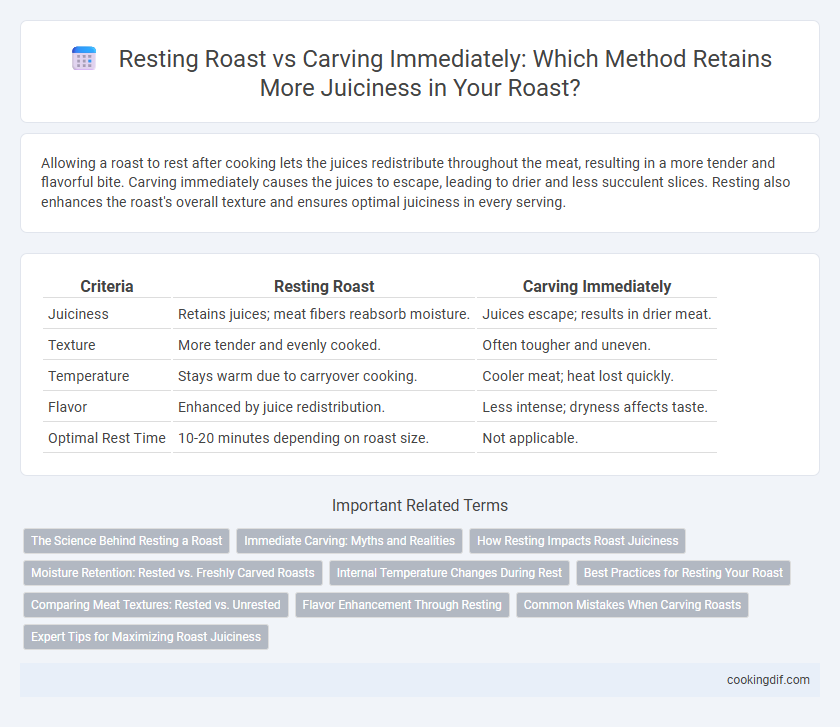Allowing a roast to rest after cooking lets the juices redistribute throughout the meat, resulting in a more tender and flavorful bite. Carving immediately causes the juices to escape, leading to drier and less succulent slices. Resting also enhances the roast's overall texture and ensures optimal juiciness in every serving.
Table of Comparison
| Criteria | Resting Roast | Carving Immediately |
|---|---|---|
| Juiciness | Retains juices; meat fibers reabsorb moisture. | Juices escape; results in drier meat. |
| Texture | More tender and evenly cooked. | Often tougher and uneven. |
| Temperature | Stays warm due to carryover cooking. | Cooler meat; heat lost quickly. |
| Flavor | Enhanced by juice redistribution. | Less intense; dryness affects taste. |
| Optimal Rest Time | 10-20 minutes depending on roast size. | Not applicable. |
The Science Behind Resting a Roast
Resting a roast after cooking allows the muscle fibers to reabsorb and redistribute the juices, enhancing overall juiciness. Cutting into a roast immediately causes the juices to escape, resulting in a drier texture. This process is driven by the natural cooling and relaxation of meat fibers, which improves moisture retention and flavor intensity.
Immediate Carving: Myths and Realities
Carving a roast immediately after cooking is often believed to preserve juiciness, but this can lead to excessive juice loss as the meat fibers have not yet relaxed. Resting allows internal juices to redistribute, resulting in a more tender and flavorful roast. Research shows that slicing too soon accelerates moisture runoff, reducing overall succulence.
How Resting Impacts Roast Juiciness
Resting a roast allows the redistributed juices to settle evenly throughout the meat, enhancing overall moistness and flavor intensity. Carving immediately causes the hot juices to escape rapidly, resulting in a drier texture and less savory experience. Studies show that resting for 10-20 minutes can retain up to 20% more moisture compared to slicing right away.
Moisture Retention: Rested vs. Freshly Carved Roasts
Resting a roast allows the juices to redistribute evenly throughout the meat fibers, resulting in enhanced moisture retention and juicier slices compared to carving immediately. Freshly carved roasts often lose more liquid as the muscle fibers have not yet relaxed, causing moisture to escape rapidly. Studies on beef and pork roasts show resting for 10-20 minutes significantly improves tenderness and juiciness by maintaining internal moisture.
Internal Temperature Changes During Rest
Resting roast allows the internal temperature to stabilize and even rise by 3 to 5degF after removal from heat, which helps redistribute juices evenly throughout the meat. Cutting immediately prevents this temperature equilibration, causing juices to flow out rapidly and resulting in a drier roast. Monitoring internal temperature changes during the resting phase is crucial for achieving maximum juiciness and optimal texture.
Best Practices for Resting Your Roast
Resting a roast for 15 to 20 minutes allows juices to redistribute evenly throughout the meat, enhancing overall juiciness and tenderness. Cutting into the roast immediately causes the juices to escape, resulting in a drier texture and less flavorful bite. For optimal results, tent the roast loosely with foil during resting to retain warmth without steaming the meat.
Comparing Meat Textures: Rested vs. Unrested
Resting roast meat allows the juices to redistribute throughout the muscle fibers, resulting in a more tender and juicy texture compared to carving immediately. Cutting into a roast right after cooking causes the juices to escape, leading to a drier and tougher mouthfeel. Studies show that rested meat retains up to 30% more moisture, significantly enhancing flavor and tenderness.
Flavor Enhancement Through Resting
Resting a roast after cooking allows the juices to redistribute evenly, enhancing the overall flavor and moisture throughout the meat. Cutting into the roast immediately causes these flavorful juices to escape, resulting in a drier, less savory bite. Proper resting time, typically 10 to 20 minutes depending on size, intensifies the roast's tenderness and enriches its taste profile.
Common Mistakes When Carving Roasts
Resting a roast for at least 15-20 minutes allows the juices to redistribute, preventing dry, tough meat commonly caused by carving immediately. Cutting into the roast too soon causes valuable juices to escape, resulting in a less flavorful and drier meal. Many mistakes during carving stem from impatience and using improper knives, leading to uneven slices and loss of moisture.
Expert Tips for Maximizing Roast Juiciness
Resting a roast for at least 15-20 minutes allows the juices to redistribute evenly, preventing them from spilling out during carving and resulting in a more succulent bite. Cutting into the roast immediately causes the muscle fibers to contract and release moisture, leading to a drier texture. Experts recommend using a meat thermometer to ensure optimal internal temperature, then resting the meat loosely tented with foil to maximize roast juiciness.
Resting roast vs carving immediately for juiciness Infographic

 cookingdif.com
cookingdif.com